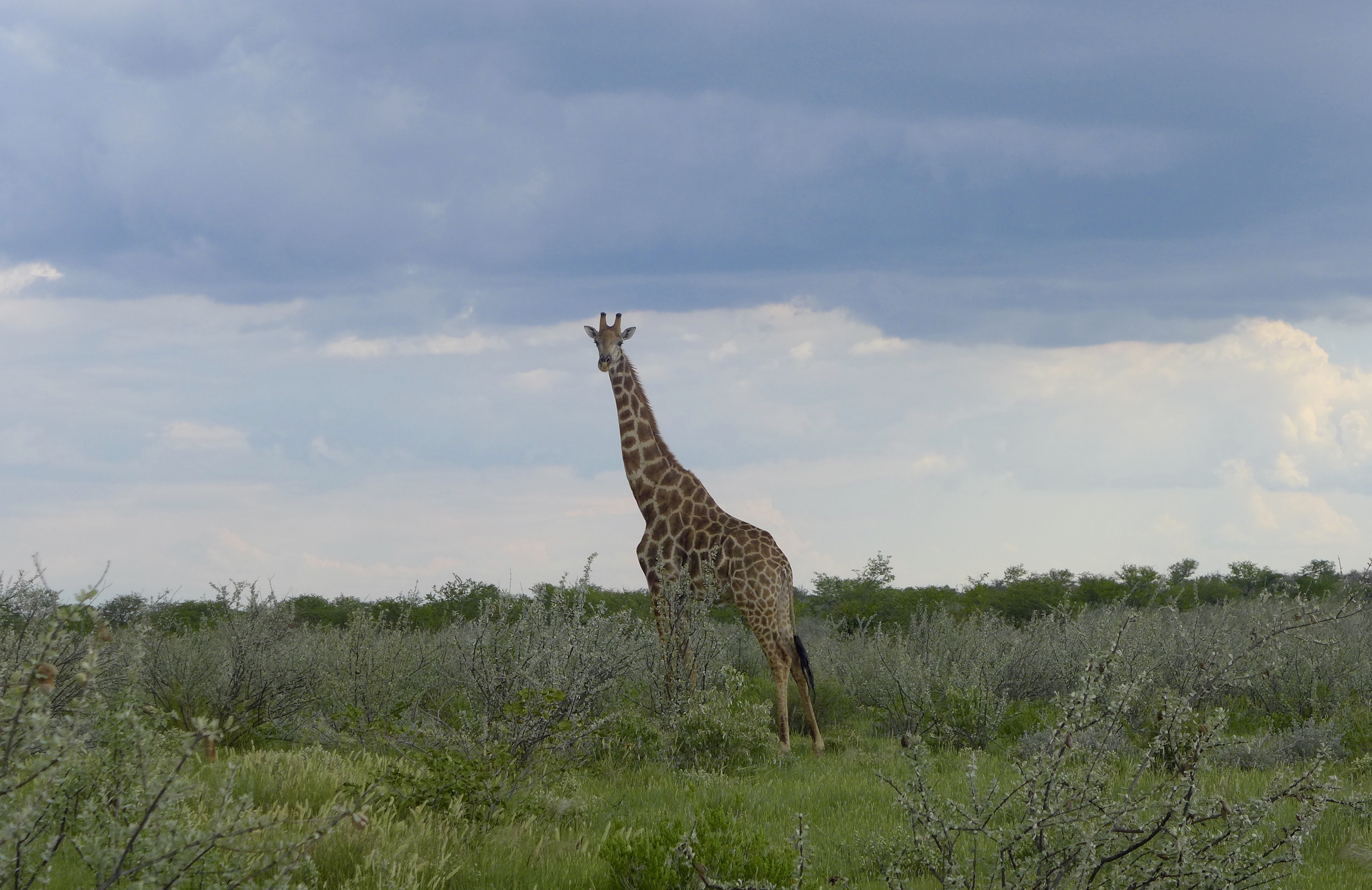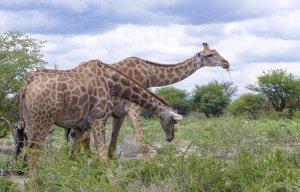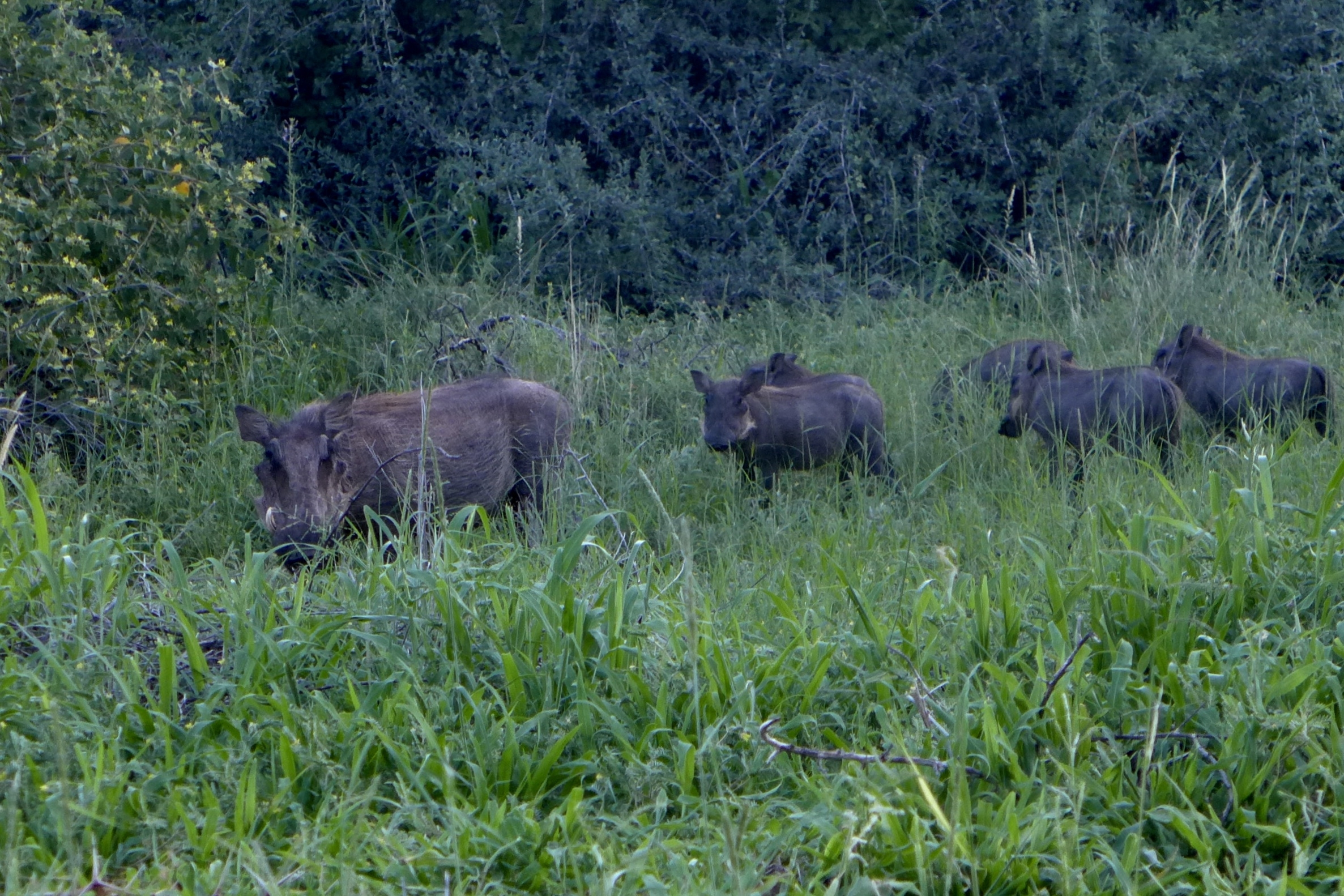When we left the green, grassy plains of Etosha and said goodbye to our last Wildebeest, I was not fully aware of the vastness of the desert lands that cover a large portion of Namibia. Some stretches of the landscape felt familiar and reminded us of Texas with its scraggy trees and tall grasses. Others, the tall red mesas and rocky ground looked like we could have been driving in Western Colorado, Arizona or Utah. However, as we traveled from Ethosha to Damaraland (an area that, after Apartheid ended, was renamed the Kunene region) and then on to the costal town of Swakopmund, we drove through deserts the like of which I had never seen before; deserts that make myths and fairytales.
Miles and miles of flat sand dominated the view out the windows of our trucks. The heat rising off the road tricked our eyes into seeing shimmering water on the horizon. As if in a storybook, I half expected to see figures traversing the barren sands on camelback. In reality, the only tall object to break up the view was the occasional lone Ostrich with his fluffy black feathers blowing in the hot wind. Africa is one of those places where you have to keep pinching yourself as a reminder that you are indeed awake and not in a dream. One of my favorite images of our drive was on the road through the Kunene Region. We drove up and down dirt roads past random, single shacks made of driftwood and then, in the distance, we saw a woman spinning around and around; her billowy, brightly colored Victorian-style dress caught the sun with the hope that we would stop and buy one of the glittering crystals she had on display at her roadside stand.
The Kunene Region has over 45,000 ancient rock paintings tucked into the red, sandstone peaks; the most famous is called The White Lady and is found on Brandberg Mountain. Much of the time, the Desert Elephant is also found in this region. Their feet are wider than those of other elephants, which allow them to lumber through the sand and over rocks with greater ease. Sadly, we were unaware that they actually migrate long distances in search of water and move away from the heat of the Namib Desert in summer. Other than the elephant crossing signs on the side of the roads, the only evidence we saw of them were the broken trees left in their wake on the hike to The White Lady (it was a dangerously hot hike and should only be taken at daybreak during the summer or not at all).
For most of our trip through Namibia, azure blue coated the sky; a blue equal to that of the famous blue of Colorado’s skies. However, as if passing through some invisible curtain, the sky suddenly changed to thick, gray clouds and the dry, hot wind became cool and sticky with moisture it had picked up from the ocean. We arrived at Skeleton Coast where the desert meets the sea. Low bushes growing in the sand were the only signs of vegetation we saw as we snaked through the dunes on black, salt roads. Swakopmund is a German colonial town that houses most of the people of this coastal area. We were told that more often than not the sky is overcast and gray but it rarely rains. There is a quaint, walk-able downtown with tons of tourist shops and cafes.
Walvis Bay, 20 minutes down the road, has a large wetland area where you can get your National Geographic moment and watch millions of flamingos munch on shrimp and algae; their zipper-like chatter fills the air. We watched them for what seemed like hours as they flew through the sky and landed with a run on the surface of the water. I had never seen them fly and so I was unaware of their gorgeous wings with a swath of pink changing to black at the tips of their feathers.
We stayed at a bed and breakfast in Swakopmund called The Alternative Space. This home, with its white washed walls and interior garden courtyard, was our oasis from our regular hot, dusty campsites. The description of the guesthouse on the itinerary from the travel agency said, “The Space is not recommended for persons who find pictures of nudity offensive”, which of course gave us a bit of a pause. In reality our hosts, Sibyle and Frenus, have a beautiful collection of paintings from local artists and their own photography adorn the walls like a gallery. Frenus thinks of their establishment as one for the “upscale backpacker”; its aim is to attract those wanderlust people who no longer want to endure the smells and snores of hostels but also want to travel on a budget. It did feel like a luxury resort with the gorgeous spread of food provided at breakfast and the large, airy rooms with comfy beds. Our room was a sort of a “free-form” family room with no walls or door for the bathroom. A lovely claw foot tub sat toward the back of the room to signal the bathroom space and a single pipe with a shower-head hung down from the ceiling. It was liberating to take a shower out in the open with no doors to restrict your movement.
We left Swakopmund and drove back through the mysterious curtain into the hot desert. The road took us around Zebra Mountain where we watched a herd of zebras run next to the car and then across the road (remember that pinching yourself thing? Yeah, had to do it again). We landed at the Sesrium Camp just in time for sunset. Out of all the campsites, I think this one was my favorite. It was a large circle with a huge Camelthorn Acacia tree in the middle that quenched our thirst for shade. Our site was located on the edge of the campground and so we had an unobstructed view of the rocky field where Springboks quietly grazed in front of the mountains as the sinking sun washed everything in an auburn hue.
Sesrium is located in the Namib-Naukluft National Park and the main reason to visit here is to explore the red sand dunes that surround Sossusvlei and to see the ghostly trees of Deadvlei. The best time to venture into the dunes is either just before sunrise or sunset and many hikers climb to the top of “Dune 45” to take in the show. The sunlight at dawn and dusk paints the dunes in amazing purples, rusts and deep red and the acacia trees pop with lime green. If you have a bucket list, put this place on it. A 4 x 4 vehicle is a must if you want to make it all the way to Sossusvlei or for a small price, catch a ride with a large transport truck in the high season. We all piled into one truck, my Dad at the wheel, and bounced and slid through the dense sand — true four-wheeling style. I know my Dad was thankful for his expertise in driving through snow because we had a moment when we thought we were stuck and would be locked out of our campsite (I guess everything turns back into a pumpkin at sundown if you are not through the gates in time).
Words cannot adequately describe the beauty of these dunes. The wind blows the sand into artful designs and in some places, with the help of the long shadows creates the stripes of the zebra. Jacob and Mackenzie scrambled up and over several of the dunes to catch a glimpse of Deadvlei. I think Mackenzie could have cared less about seeing the skeleton trees. She really just wanted to slide down a dune, which she did and then preceded to empty her shoes of the bucket loads of sand that had collected inside them.

Our last stop before heading back to Windhoek was in the Kalahari Desert. The Kalahari actually receives between 5-10 inches of rain per year so instead of a barren wasteland, it is filled with soft grasses, bright yellow flowering bushes and of course Acacia trees. The Kalahari also has its share of dunes and the locals call the space between them the streets of the Kalahari. We stayed at the Bagatelle Kalahari Game Ranch outside a town called Mariental. It was another cherished oasis and a free upgrade since the original booking was closed for repairs. We quickly found the outdoor patio, shade and cool drinks savoring our relaxation until it was time for dinner. The girls donned their swimsuits, jumped into the cool clean pool and rescued dragonflies and grasshoppers from drowning in the water. Springbok were of course in plenty and the owners of the ranch have even adopted one for a pet who came for a visit during dinner.
I am so very aware of how privileged I am to be on this trip and also to have parents who could come and share a piece of it with us. I love that I have a picture of my parents looking through binoculars into the game reserve searching for wildlife. I love that we shared the experience of the crazy rooftop tents, baboons, the scorching heat of the desert and the magical elephants. I love that I have a memory of watching them try to negotiate the overwhelming persistence of the sales people in the street and were duped (as was I) into buying too many carved nut ornaments. I love that they are home now telling their friends and family about their adventures with us (and hopefully getting us more followers… hint, hint.); proudly owning the Namibian stamp in their passports with the realization that they might need more stamps from other countries to keep it company. I know I do.













